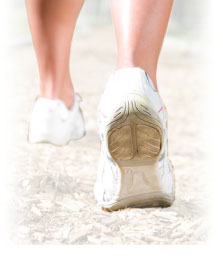History and Presenting Symptoms
A 38-year-old female reports the recent onset of pain at her left knee. She had started a fitness walking program in the past six months, and had gradually increased to two miles every day. She doesn’t recall any specific injury, and describes the pain as an aching soreness in her left knee that builds up during the day and, particularly, after walking. Advil is some help, but she doesn’t want to continue taking anti-inflammatory drugs. On a 100 mm Visual Analog Scale, she rates her left knee pain at about 55 mm.
Exam Findings
Vitals. This fit-appearing woman stands 5’7″ and weighs 152 lbs., which results in a BMI of 23 – she is not overweight. She has never smoked tobacco, and her blood pressure and pulse rate are in the normal ranges.
Posture and gait. Standing postural evaluation finds generally good alignment throughout her pelvis and spine. She has a mild left knee valgus and moderate calcaneal eversion and obvious hyperpronation on the left side. Measurement finds a standing Q-angle of 28° on the left and 23° on the right (20° is normal for women). Measurement of her navicular drop from seated to standing identifies a medial arch drop of 9 mm on the left and 4 mm on the right, with an asymmetry of 5 mm.
Chiropractic evaluation. Motion palpation identifies several mild limitations in spinal motion: the left SI joint, the lumbosacral junction, T11/12, and the cervicothoracic junction. There is no localized tenderness in these regions, and all spinal, hip, and knee ranges of motion are full and pain-free.

Primary complaint. Orthopedic testing of the left knee finds no ligament instability, but the patellar grinding test produces pain upon contraction of the quadriceps with only moderate pressure. All knee ranges of motion are full and pain-free, bilaterally. Manual muscle testing finds no evidence of local muscle weakness.
Imaging
No imaging of the knees or spine was performed.
Clinical Impression
Patellofemoral pain (previously chondromalacia patellae) on the left, associated with an elevated Q-angle and asymmetrical foot pronation. This is accompanied by sacroiliac and lumbosacral joint motion restrictions and compensatory lower thoracic and cervicothoracic fixations.
Treatment Plan
Adjustments. Specific, corrective adjustments for the SI joints and the lumbar, thoracic, and cervical regions were provided as needed. Mobilization of the left knee into external rotation was performed to decrease the internal rotation associated with hyperpronation and her elevated Q-angle. Manipulation of the left navicular, cuboid, and calcaneal bones was also performed.
Support. Custom-made, flexible stabilizing orthotics were supplied, with a pronation correction added on the left. Two pairs of stabilizing orthotics were ordered, one designed specifically for her walking shoes and the other for her job-related dress shoes. She reported that she quickly became used to them in her walking shoes, and she had no difficulty in adapting to the stabilizing orthotics in her work shoes.
Rehabilitation. She was encouraged to continue her two-mile daily walks at a comfortable and relaxing pace. As she got used to her stabilizing orthotics, she was permitted to gradually increase her tempo and distance. Simple isometric quadriceps strengthening exercises were demonstrated and asked to be performed on a daily basis.
Response to Care
The spinal and knee adjustments were well-tolerated, and she reported a rapid decrease in symptoms. Once she began wearing her orthotics regularly, she noted a substantial decrease in knee irritation during and after walking. After eight weeks, she had built up to walking three miles every day, with no return of her left knee pain. At that point, she was released to a self-directed maintenance program.
Discussion
Because of a wider pelvis, women naturally have higher Q-angles at the knee. When they are physically active (especially with a regular walking or running program), this frequently results in patellofemoral pain. This condition was previously called chondromalacia patellae, but is now known to be a biomechanical “tracking” disorder of the kneecap in the femoral groove. Conservative treatment that addresses any biomechanical asymmetries is very effective. This usually entails a combination of chiropractic adjustments and flexible orthotic support combined with quadriceps strengthening exercises.
 Dr. John J. Danchik, the seventh inductee to the ACA Sports Hall of Fame, is a clinical professor at Tufts University Medical School and formerly chaired the U.S. Olympic Committee’s Chiropractic Selection Program. Dr. Danchik lectures on current trends in sports chiropractic and rehabilitation.
Dr. John J. Danchik, the seventh inductee to the ACA Sports Hall of Fame, is a clinical professor at Tufts University Medical School and formerly chaired the U.S. Olympic Committee’s Chiropractic Selection Program. Dr. Danchik lectures on current trends in sports chiropractic and rehabilitation.
